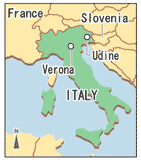(8) A tree in Hiroshima spreads peace in Italy by Makiko Yamada
My father was a soldier in World War II and was taken prisoner by the former Soviet Union in the Kuril Islands. He was held captive and endured hard labor for two years before returning to Japan. As my younger sister and I grew up, he often told us about his wartime experiences.

Children planting the second-generation seedlings of the paulownia tree from Hiroshima at an elementary school in northern Italy. (April 2006)
Makiko Yamada
Born in Hokkaido. After graduating from Musashino Art University, she studied in Italy. In 1981, she married an Italian man and moved to Italy, where she has lived for 26 years while raising two children. She works as a translator and interpreter and is active in peace education and global issues.
When I entered elementary school, my parents gave me a book. The title of the book was "Boys and Girls Around the World" and, in the section on Japan, it included the story "Sadako's Wish". It was the story of Sadako Sasaki, the girl who inspired the Children's Peace Monument in Peace Memorial Park. I was very young then, so I could barely read it, but I still clearly felt the sorrow of this girl who lost her life to the atomic bomb.
After I grew older, I studied in Italy and eventually married an Italian man. In 1990, just after my second child was born, my friend in Tokyo sent me a children's book about the atomic bomb called "Hiroshima No Pika". She asked if I would translate it into Italian so it could be used to promote peace in Italy. A friend then helped me find a small publishing company so the new Italian version could be printed. The book had already been translated into twelve languages so the Italian translation was the 13th version.
We had a party to celebrate the new book at a Catholic church in the suburbs of Udine city. The church runs a volunteer group, E. Balducci Association Center, which provides support to refugees and immigrants. Since then, I have been a member of the group and I have arranged for A-bomb survivors to share their experiences in order to convey the horror of nuclear weapons and war to the people of Italy.

Also, the staff of E. Balducci Association Center were moved by the fact that a paulownia tree had survived the bombing of Hiroshima and they planted two paulownia seedlings in their garden which came from this tree. Those two seedlings then resulted in more than ten second-generation paulownia trees in northern Italy.
In 2003, a peace group against the war in Iraq sent one of those trees to an elementary school along the national border with Slovenia. The second-generation trees grew very healthy so these paulownia trees, a legacy of that original tree which survived the bombing, are now into their third generation. An agricultural high school, whose students are involved in peace activities, is now taking care of them.
That paulownia tree in Hiroshima serves to foster a peaceful heart so that the atomic bomb tragedies of 62 years ago will not be repeated. It's as if this tree calls people to create a world without war. And I am one of many who gather in the spirit of the tree to promote peace alongside the A-bomb survivors who overcame their hardship for this noble goal.
For me, the cities of Hiroshima and Nagasaki are the heart of peace for our planet.